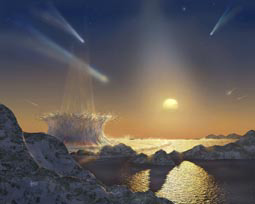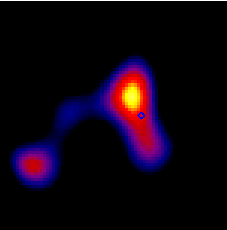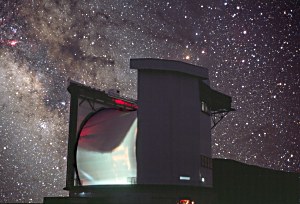Those hoping to find ET in the relatively near star system of Tau Ceti, in the constellation of The Whale will be sorely disappointed to learn that there is some ten times as much material orbiting the star in the form of asteroids and comets as there is orbiting the Sun. The outlook for any putative form of life emerging on a planet orbiting Tau Ceti will be gloomy, to say the least, with the likelihood of extinction-scale impacts riding high.
Tau Ceti is a mere twelve light years away and is the nearest Sun-like star to Earth, it can be seen clearly in the night sky without the aid of binoculars or a telescope. Exobiologists have pinned their hopes on this star system since the earlier discovery that it is orbited by a disk of matter of a similar size and shape to the comets, planets and asteroids that circulate around the Sun. However, knowing for certain the composition of this disk could settle the debate about possible homes for extraterrestrial life there.

When world’s collide – Life would be tough indeed if it exists on a planet orbiting Tau Ceti, frequent meteor and comet strikes are likely. (Credit: David Hardy)
The exobiologists’ dreams may have been shattered by Jane Greaves of the University of St Andrews and her colleagues at the Royal Observatory, in Edinburgh. They have analysed images from the world’s most sensitive submillimetre camera, SCUBA, which was built in Edinburgh and is operated on the James Clerk Maxwell Telescope in Hawaii. The SCUBA images clearly show a disk of very cold dust (at minus 210 Celsius) in orbit around Tau Ceti. The dust, explains Greaves is produced by countless collisions between larger comets and asteroids as they race around the star. The amount of dust determined is ten times as much as is seen in our own Solar system, according to the team writing in the July issue of the Monthly Notices of the Royal Astronomical Society. Even though Tau Ceti is the nearest Sun-like star, any planets that might orbit it would not be likely to support life as we know it because of the frequent and devastating impacts they would sustain from the asteroids and comets.
The findings almost suggest that the tranquil space environment around the Earth is as unusual as many people had suspected. Astronomers are yet to find planets orbiting Tau Ceti, so the concept of an exobiology there might be a non sequitur. We don’t yet know whether there are any planets orbiting Tau Ceti, says Greaves, but if there are, it is likely that they will experience constant bombardment from asteroids of the kind that is believed to have wiped out the dinosaurs. It is likely that with so many large impacts life would not have the opportunity to evolve. The reason for the much larger number of comets orbiting Tau Ceti compared with the Sun is not fully understood, explains team member Mark Wyatt, It could be that our Sun passed relatively close to another star at some point in its history and that the close encounter stripped most of the comets and asteroids from around the Sun.

SCUBA diving right into the Tau Ceti system to reveal its surrounding disc of matter (Credit: James Clerk Maxwell Telescope)
Despite this disheartening result for the exobiologists, a boost in the form of new pictures from the Hubble Space Telescope could bring new hope to those scientists hunting for ET. A sweep of the bulge at the centre of our galaxy by the condemned telescope has revealed one hundred putative planets around stars other than the Sun. The finding essentially doubles the number of so-called extra-solar planets observed over the last nine years, and could be Hubble’s saving grace rather than its swan song as US officials rethink the telescope’s maintenance schedule.

The silvery dome of the James Clerk Maxwell Telescope looks out on Tau Ceti, showing how life could take a hammering on a distant world. (Credit: Nik Szymanek)
Greaves adds that, We will have to look for stars which are even more like the Sun, in other words, ones which have only a small number of comets and asteroids. It may be that hostile systems like Tau Ceti are just as common as suitable ones like the Sun. She adds that the Hubble results will be truly outstanding if it can be confirmed that the reduction in the stellar brightness is caused by a transiting planet. Our research is starting to probe the environs of such systems to attempt to gain knowledge as to what these ‘solar systems’ might be like, she told Spotlight, Vast amounts of cold dust are likely to be indicative of a large population of comets and if there is no giant planet, like Jupiter, to deflect the comets and asteroids we believe this has profound implications for possible life on inner planets, that might resemble Earth.
Further reading
Monthly Notices Royal Astron Soc , 2004, 351, L99
http://dx.doi.org/10.1111/j.1365-2966.2004.08066.x
University of St Andrews Astronomy Group
http://star-www.st-and.ac.uk/astronomy/
Suggested searches
astrobiology
extrasolar planets
Cetus